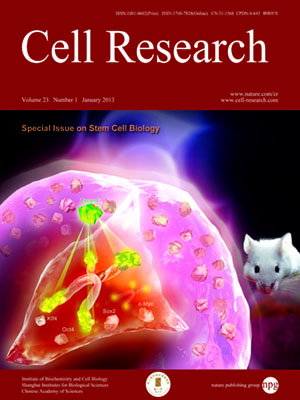
Volume 23, No 1, Jan 2013
ISSN: 1001-0602
EISSN: 1748-7838 2018
impact factor 17.848*
(Clarivate Analytics, 2019)
Volume 23 Issue 1, January 2013: 20-32
REVIEWS
The transcriptional regulation of pluripotency
Jia-Chi Yeo1,2 and Huck-Hui Ng1,2,3,4,5
1Gene Regulation Laboratory, Genome Institute of Singapore, 60 Biopolis Street, #02-01 Genome Building, Singapore 138672, Singapore
2School of Biological Sciences, Nanyang Technological University, Singapore 637551, Singapore
3Department of Biochemistry, Yong Loo Lin School of Medicine, National University of Singapore, 8 Medical Drive, Singapore 117597, Singapore
4Department of Biological Sciences, National University of Singapore, Singapore 117543, Singapore
5NUS Graduate School for Integrative Sciences and Engineering, National University of Singapore, Singapore 117456, Singapore
Correspondence: Huck-Hui NG,(nghh@gis.a-star.edu.sg)
The defining features of embryonic stem cells (ESCs) are their self-renewing and pluripotent capacities. Indeed, the ability to give rise into all cell types within the organism not only allows ESCs to function as an ideal in vitro tool to study embryonic development, but also offers great therapeutic potential within the field of regenerative medicine. However, it is also this same remarkable developmental plasticity that makes the efficient control of ESC differentiation into the desired cell type very difficult. Therefore, in order to harness ESCs for clinical applications, a detailed understanding of the molecular and cellular mechanisms controlling ESC pluripotency and lineage commitment is necessary. In this respect, through a variety of transcriptomic approaches, ESC pluripotency has been found to be regulated by a system of ESC-associated transcription factors; and the external signalling environment also acts as a key factor in modulating the ESC transcriptome. Here in this review, we summarize our current understanding of the transcriptional regulatory network in ESCs, discuss how the control of various signalling pathways could influence pluripotency, and provide a future outlook of ESC research.
Cell Research (2013) 23:20-32. doi:10.1038/cr.2012.172; published online 11 December 2012
FULL TEXT | PDF
Browse 5027


